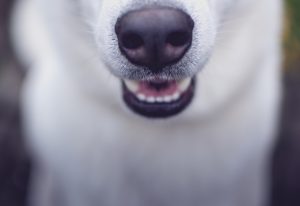This may come as a surprise: 50% of dogs by the age of 10 have missing teeth and over 85% have some stage of periodontal disease—which means there is a lot of calculus (gunk) and gingivitis (inflamed gums) in the dog’s mouth. This often leads to bone loss, infection, and lots of pain. But there are things we can do to help prevent and manage dental decay. For dogs, dental health is key.

Prevention is key when it comes to dental disease and it has long been known that the gold standard is brushing your dog’s teeth. Brushing teeth daily can significantly reduce plaque and gingivitis--the leading c
ause of problems such as infection and bone loss. Infection is caused by the buildup of bacteria which is what creates dental plaque to begin with. This inflames the gumline and leads to irritation. Beyond that, the more bacteria grow and infiltrate, the more they can eat away at the tooth. Brushing teeth daily can help greatly disrupt this process.
It’s important to note that plaque starts to accumulate as soon as 24 hours after the last tooth brushing, so it is very important to brush daily or at the very least, every other day. As frustrating as it is, brushing teeth is worthless unless done at a regular frequency.
To start brushing teeth, you can look for a tooth brushing kit for pets. One often includes a dog-safe toothpaste, an angled toothbrush to make brushing the dog’s mouth easier, and a little finger cap-like piece that has bristles on it.
First, try to find a flavor of toothpaste your dog likes to make it a pleasant experience. Give a bit as a treat, and then use your finger (without the cap) to rub some paste on your pup’s teeth. Get your dog used to this feeling. Next, try adding the finger cap and then move to a toothbrush if you are able. The distinction between the finger cap and toothbrush is minimal as the friction of brushing teeth is what does most of the work removing plaque.
It is important to keep in mind that while using human toothbrushes is not a problem, there are a lot of ingredients in human-grade toothpaste that can be quite toxic for pets. So stick to pastes that are made for dogs, only.
 You may find that your dog will not tolerate brushing teeth. This is completely understandable, especially if you are starting your pup at an older age. If this is the case, the next best thing would be dental treats. These are sold over the counter at a variety of pet stores nationwide and are easy to acquire. They often taste delicious and encourage the dog to eat them without any work for you. The trick with these treats is that they provide some of the friction that toothbrushing would provide due to the way they are produced. As your dog chews, some of the plaque gets removed.
You may find that your dog will not tolerate brushing teeth. This is completely understandable, especially if you are starting your pup at an older age. If this is the case, the next best thing would be dental treats. These are sold over the counter at a variety of pet stores nationwide and are easy to acquire. They often taste delicious and encourage the dog to eat them without any work for you. The trick with these treats is that they provide some of the friction that toothbrushing would provide due to the way they are produced. As your dog chews, some of the plaque gets removed.
Of course, not all the teeth get equal coverage and some dogs don’t chew the treats for long enough to benefit. Still, if you are struggling to brush your dog’s teeth or your schedule does not allow you to brush your dog’s teeth frequently, this is a great, next best choice. Just remember to offset the calories in this new added treat by taking away other treats, or feed just slightly less throughout the day.
On a similar note, chew toys are a great way to care for your dog’s teeth. It is important to remember that not all dogs like chewing toys, and that toys can also be too hard. If you choose a toy that is too hard, you risk your dog fracturing a tooth. To test a dental chew or bone, you can use your nail to make an indentation in the toy. If you can’t, the toy is too hard.
Larger dogs are more prone to chew on toys that are too hard and frequently fracture teeth. These fractured teeth are then more prone to infection. On that note, if your dog likes to rip toys apart, as many Labradors Retrievers do, this may not be a great option as they could swallow a chunk and get it stuck in their digestive tract.
The last preventative point related to dental health for dogs would be water additives. There has been some mixed information on it. While there is evidence that water additives can help reduce plaque to some extent, veterinary dentists say it is not nearly as significant as the methods mentioned above. If you are trying to decide between a water additive or brushing your dog’s teeth, save your money and choose brushing and treats. If you plan on doing nothing at all, then a water additive may be helpful.

If your dog develops dental disease, it is important to work with your veterinarian and monitor for symptoms early on, like behavioral changes. Not all dental or behavioral changes result from normal aging. If you notice any issues, make sure to bring them up at your next routine appointment. Dogs tend to act very differently at the clinic due to the stress and excitement, and a veterinarian may only get a snapshot of your dog’s behavior.
Other important signs and symptoms include the following: bad breath, refusing to eat certain foods, weight loss and decreased appetite. If you notice any of these symptoms, be sure to mention it to a veterinarian. If dental disease is ignored, it can cause significant pain to your dog, and could eventually lead to an abscess. An abscess is a swollen part of the body that has a lot of pus. Abscesses can erupt, which would leave your dog with what would look like a puss filled hole in its jaw. Not only is this painful, it can also have a much longer recovery time and lead to additional medical conditions elsewhere in the body. Moreover, even if an abscess is not present, diseased teeth can lead to systemic infection as the bacteria from the teeth could enter the bloodstream.
Once your veterinarian either confirms or suspects a dental condition, they will likely recommend a professional dental cleaning under anesthesia paired with dental radiographs (x-rays). Dental radiographs help veterinarians see underneath the gum line and evaluate bone and ligament loss in the tooth. It also helps veterinarians look for anything that shouldn’t be there such as fragments of a lost tooth or something your dog chewed on that got stuck and is now causing problems. Once these radiographs are taken and evaluated, the veterinarian can then decide what treatment plan would be most appropriate for your dog.
At the end of the day, listen to your veterinarian. If you are hesitant, get a second opinion or go to a board-certified veterinary dentist. These specialists are veterinarians who have undergone additional training to specialize in all things tooth related. You can use the following link to find a specialist near you: https://avdc.org/find-vet-dental-specialist/.
Some people may be concerned that if a veterinarian recommends extracting teeth repeatedly, your dog may end up with no teeth. The reality is, this may happen. Veterinarians are not going to recommend removing healthy teeth, however, and as mentioned above, diseased teeth can lead to a lot of other problems. In this way, it is better to have no teeth than rotten teeth, and your dog can live very well with no teeth in the long term.
The biggest concern for owners of toothless dogs is what to feed. While it is true that eating large treats or kibble will prove more difficult and could be dangerous, there are a lot of great options out there. Kibble exists in a large variety of different shapes and sizes, and many dogs fair just fine with a smaller kibble. For those that don’t but still like the flavor of a certain hard food, you can add some warm water or chicken broth with no sodium to help soften the kibble.
Additionally, there are a lot of great soft foods for dogs that provide all the nutrition your dog may need. Your dog may even prefer the flavor of soft food to their previous hard food.
Dogs can experience dental problems which can lead to a lot of systemic issues and pain, but there are a lot of things we can do to prevent them and a lot we can do to manage them once they happen. And if you find yourself with a toothless dog, just know that it was the best thing for your pup, and that he will no longer be in pain or at risk of additional conditions caused by their mouth.
~~~
Photo credits:
Feature: Yoav Hornung, Unsplash, Smiling white dog: Marek Szturk, Unsplash, Small dog, Kim. Becker, Unsplash, Brown dog: Fox, Unsplash
Sources:
[1] Kyllar, M., & Witter, K. (2012). Prevalence of dental disorders in pet dogs. Veterinární Medicína, 50(No. 11), 496-505. doi: 10.17221/5654-vetmed; Gorrel, C., & Rawlings, J. (1996). The Role of Tooth-brushing and Diet in the Maintenance of Periodontal Health in Dogs. Journal Of Veterinary Dentistry, 13(4), 139-143. doi: 10.1177/089875649601300405; Clarke, D. (2006). Drinking Water Additive Decreases Plaque and Calculus Accumulation in Cats. Journal Of Veterinary Dentistry, 23(2), 79-82. doi: 10.1177/089875640602300203; Niemiec BA, ed. Veterinary Periodontology. Ames, IA: Wiley Blackwell; 2013.

